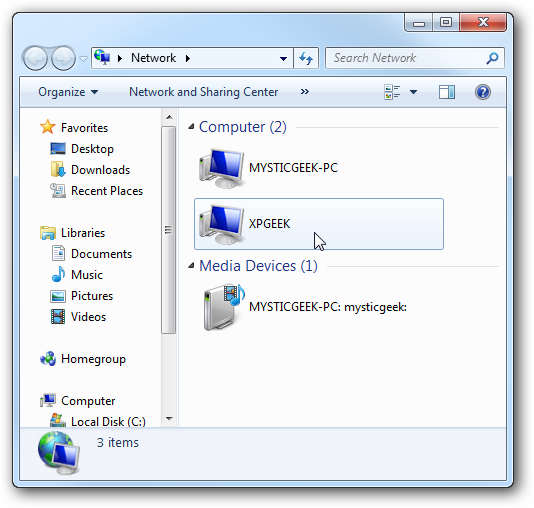Complete Guide to Networking Windows 7 with XP and Vista
Posted
by Mysticgeek
on How to geek
See other posts from How to geek
or by Mysticgeek
Published on Tue, 20 Apr 2010 12:00:00 +0000
Indexed on
2010/04/20
12:13 UTC
Read the original article
Hit count: 1517
Managing Files and Folder
|Network and Internet
|networking
|Networking and Sharing
|Vista
|Windows 7
|XP
Since there are three versions of Windows out in the field these days, chances are you need to share data between them. Today we show how to get each version to be share files and printers with one another.
In a perfect world, getting your computers with different Microsoft operating systems to network would be as easy as clicking a button. With the Windows 7 Homegroup feature, it’s almost that easy. However, getting all three of them to communicate with each other can be a bit of a challenge. Today we’ve put together a guide that will help you share files and printers in whatever scenario of the three versions you might encounter on your home network.
Sharing Between Windows 7 and XP
The most common scenario you’re probably going to run into is sharing between Windows 7 and XP. Essentially you’ll want to make sure both machines are part of the same workgroup, set up the correct sharing settings, and making sure network discovery is enabled on Windows 7. The biggest problem you may run into is finding the correct printer drivers for both versions of Windows.

Share Files and Printers Between Windows 7 & XP
Map a Network Drive
Another method of sharing data between XP and Windows 7 is mapping a network drive. If you don’t need to share a printer and only want to share a drive, then you can just map an XP drive to Windows 7. Although it might sound complicated, the process is not bad. The trickiest part is making sure you add the appropriate local user. This will allow you to share the contents of an XP drive to your Windows 7 computer.

Map a Network Drive from XP to Windows 7
Sharing between Vista and Windows 7
Another scenario you might run into is having to share files and printers between a Vista and Windows 7 machine. The process is a bit easier than sharing between XP and Windows 7, but takes a bit of work. The Homegroup feature isn’t compatible with Vista, so we need to go through a few different steps. Depending on what your printer is, sharing it should be easier as Vista and Windows 7 do a much better job of automatically locating the drivers.

How to Share Files and Printers Between Windows 7 and Vista
Sharing between Vista and XP
When Windows Vista came out, hardware requirements were intensive, drivers weren’t ready, and sharing between them was complicated due to the new Vista structure. The sharing process is pretty straight-forward if you’re not using password protection…as you just need to drop what you want to share into the Vista Public folder. On the other hand, sharing with password protection becomes a bit more difficult. Basically you need to add a user and set up sharing on the XP machine. But once again, we have a complete tutorial for that situation.

Share Files and Folders Between Vista and XP Machines
Sharing Between Windows 7 with Homegroup
If you have one or more Windows 7 machine, sharing files and devices becomes extremely easy with the Homegroup feature. It’s as simple as creating a Homegroup on on machine then joining the other to it. It allows you to stream media, control what data is shared, and can also be password protected. If you don’t want to make your Windows 7 machines part of the same Homegroup, you can still share files through the Public Folder, and setup a printer to be shared as well.

Use the Homegroup Feature in Windows 7 to Share Printers and Files
Create a Homegroup & Join a New Computer To It
Change which Files are Shared in a Homegroup
Windows Home Server
If you want an ultimate setup that creates a centralized location to share files between all systems on your home network, regardless of the operating system, then set up a Windows Home Server. It allows you to centralize your important documents and digital media files on one box and provides easy access to data and the ability to stream media to other machines on your network. Not only that, but it provides easy backup of all your machines to the server, in case disaster strikes.

How to Install and Setup Windows Home Server
How to Manage Shared Folders on Windows Home Server
Conclusion
The biggest annoyance is dealing with printers that have a different set of drivers for each OS. There is no real easy way to solve this problem. Our best advice is to try to connect it to one machine, and if the drivers won’t work, hook it up to the other computer and see if that works. Each printer manufacturer is different, and Windows doesn’t always automatically install the correct drivers for the device.
We hope this guide helps you share your data between whichever Microsoft OS scenario you might run into!
Here are some other articles that will help you accomplish your home networking needs:
Share a Printer on a Home Network from Vista or XP to Windows 7
How to Share a Folder the XP Way in Windows Vista
| Similar Articles | Productive Geek Tips |
| Latest Software Reviews | Tinyhacker Random Tips |
© How to geek or respective owner
